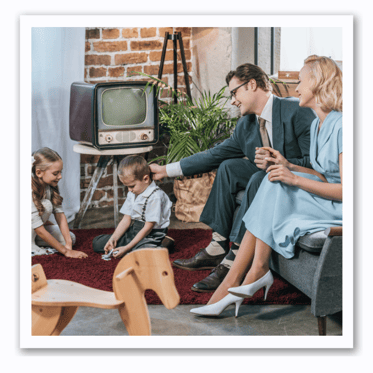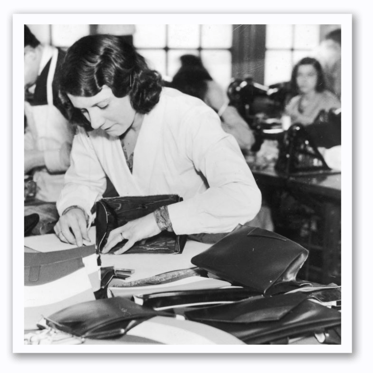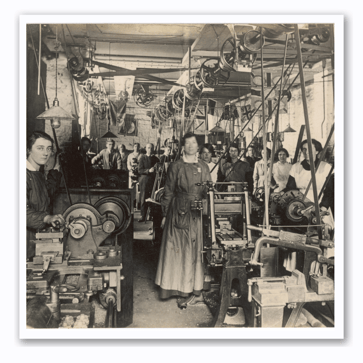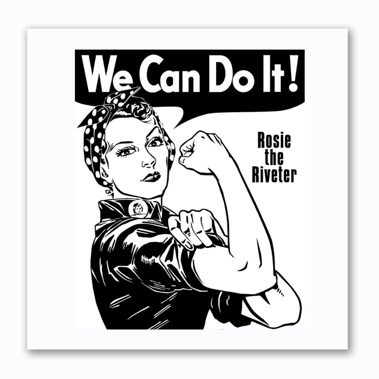This blog is the first of a 14-part series, Women in the Workforce: We Can Do It!, which explores topics related to the history, challenges, and accomplishments of working women in America.
Read more in the series:
- Women in the Workforce: We Can Do It!
- The War Opens the Doors for Working Women
- Rise of Jobs, Rise of Inequality
- Working Women and The Great Depression
- The Rise of Female Empowerment
- Stay Home or Be Paid Less
- A Woman's Place
- The Myth of the Ideal Woman
- Is This All?
- Women’s Lib Movement and the Fight for Equal Rights
- 1970s:A Decade of Change
- Climbing the Ladder and Having it ALL
- How Women in the 90s Impacted the Workforce
- The Impact of the Pandemic on Women in the Workforce
A Woman's Place. “A woman’s place is in the home.” You may be familiar with this proverb, and there can be different interpretations, both positive and negative, depending on the circumstances. This phrase has been adapted over the years, and I would bet that most variations were created by men.
The first known version of this phrase goes back to the ancient Greeks. In 467 B.C., the playwright Aeschylus wrote in “Seven Against Thebes” his views on a woman’s place, which has been translated “Let women stay at home and hold their peace.”
In 1732, English author, Thomas Fuller, used this proverb to summarize the limiting views of women in the genteel class, “A woman is to be from her house three times: when she is christened, married, and buried.”
In 1832, The New Sporting Magazine, Volume 3, clarified a woman’s place even more, “A woman’s place is in her own home, and not her husband’s countinghouse.”
 Society has long held that women are the weaker sex. Women have been believed to be physically and intellectually inferior to men. Women were considered to be too emotional to make rational decisions, and therefore, men were the head of the household, both provider and protector.
Society has long held that women are the weaker sex. Women have been believed to be physically and intellectually inferior to men. Women were considered to be too emotional to make rational decisions, and therefore, men were the head of the household, both provider and protector.
Historically, women have had limited legal rights and fewer opportunities for education. Women were supposed to marry and not trouble themselves with the work of men. I laugh at that sentiment! When Thomas Fuller stated that a woman only leaves her house three times, he was probably correct. To put that into historical perspective, in 1732, Georgia became an English colony, and you can imagine the work required of a Colonial woman. They tended to the animals, farming, cooking, preserving food, spinning, sewing, and raising children. There was no time in the day to leave home, but the idea that a woman’s constitution was not meant for work is laughable.
Few Choices. We also know that regardless of societal ideals, many women did not have a choice but to work to make a living. Whether single, widowed, or even married, many
 women were in the workforce. In the 19th century, jobs for women were primarily working in factories or performing domestic work. Women were also seamstresses and ran boardinghouses. The work was difficult, and they did not have the same legal rights, pay, or respect as men.
women were in the workforce. In the 19th century, jobs for women were primarily working in factories or performing domestic work. Women were also seamstresses and ran boardinghouses. The work was difficult, and they did not have the same legal rights, pay, or respect as men.
I come from a long line of females who worked outside the home. As a working woman myself, I am proud of the women who have come before me. They have worked out of necessity and the desire to pursue a passion. Women who work in the labor force have had to endure discrimination and struggles, but fortunately, the tide is turning.
If I asked my daughters about the proverb, “A woman’s place is in the home,” they would laugh and probably make a joke about my poor cooking skills. But I would venture to say that many of the younger generation hardly understand its significance anymore.
The History of Women in the Workforce. When I started writing this series about Women in the Workforce, my focus was on pay equity and a woman’s right to be paid equal wages for equal work. However, as I began researching the topic of wage disparity,
 I became immersed in the history of women in the workforce. The data, the laws, and the cultural views helped create images of women who are tough, hardworking, and persistent - women who fought for their families, as well as their own interests. Women who have learned, endured, succeeded, and failed. I see myself in these stories, as well as my grandmother, who worked in the textile mills, and my mother, who pursued a master's after her divorce and found a successful career. I also see my daughters’ futures, and I look forward to seeing the choices they make.
I became immersed in the history of women in the workforce. The data, the laws, and the cultural views helped create images of women who are tough, hardworking, and persistent - women who fought for their families, as well as their own interests. Women who have learned, endured, succeeded, and failed. I see myself in these stories, as well as my grandmother, who worked in the textile mills, and my mother, who pursued a master's after her divorce and found a successful career. I also see my daughters’ futures, and I look forward to seeing the choices they make.
My Story. My own story is not that different than many of the women I have read about while preparing this series. I was born in 1971 with the idea that I could accomplish anything. I remember my dad showing me boats in Hilton Head as a young child. I would point out the big yacht that I wanted to own one day. He replied that I better marry rich, and I retorted that I would be rich on my own. My parents divorced when I was in grade school, and I saw my mother go back to school and discover a successful career and life of her own.
I graduated from a prestigious university with a history degree and no clear idea of what to do. I considered teaching and remembered being told by a male friend that “I was too good to teach.” I considered law school but had concerns about the realities of raising a family and climbing the partner ladder. Ultimately, I entered the business with my father. When I was born in 1971, he probably never thought his daughter would be the one to follow him. Yet, there I was. And so far, it has been an interesting and wonderful ride. Although I have experienced success in my business, I have also experienced the challenges of being a woman in a male-dominated world.
Working Mothers. Like all working mothers, I have questioned my decisions and yearned for more. I have felt guilty at home and guilty at work. I have struggled with wanting to have it all and am concerned that I may be messing it all up! I have succeeded at much and failed miserably as well. I have learned to be okay with a messy house, take-out food, and not being at every field day. I learned to set boundaries, and I always prioritized tucking my girls into bed.
In 2015, I traveled to India with the Liberty Fellowship program. While there, I had seminars with fellows from around the world – India, China, the Middle East, South Africa, and Central America. One woman, in particular, captivated me. Nadini Singla was the Minister of External Affairs of India and had a powerful job. She was poised, kind, and the mother of two young children. She was always put together, and her saris were beautiful and perfectly draped. I remember feeling inadequate around her, thinking there was no way my accomplishments could come even close to hers.
I looked up to her as an individual and was amazed when one day she asked me, “Lee, how do you do it all?” I looked around, thinking she must be talking to someone else, but asked what she meant. She explained that she was always so impressed by women in America and all they did, particularly working mothers. She told me that in India, women who have a career have the financial ability and expectation of hiring others to help. She told me that she had a live-in nanny, a housekeeper who cooked, and a driver. She explained she was able to focus on her job while at work and focus on her family when at home.
I was stunned and then quietly proud. In that moment, I realized I don’t know how American women do it all, but we do. Whether married or single, with children or not, working part-time, full-time, or even two jobs, as a stay-at-home mom or a community volunteer, American women can do it! Throughout history, American women always have. And I am so proud we do!
 We Can Do It! Over the next few months, I will explore topics about women in the workforce from the early 1900s until the present. Also, I want to note the changing trends of women in the workforce that this series contemplates will focus on white, middle-class women. Women of color have had very different experiences, and their work lives have been defined by racism, sexism, and financial necessity. I have pointed this out when possible, but please keep in mind that this series is not a complete picture of all women.
We Can Do It! Over the next few months, I will explore topics about women in the workforce from the early 1900s until the present. Also, I want to note the changing trends of women in the workforce that this series contemplates will focus on white, middle-class women. Women of color have had very different experiences, and their work lives have been defined by racism, sexism, and financial necessity. I have pointed this out when possible, but please keep in mind that this series is not a complete picture of all women.
There are 14 blogs in this series, so please check back. And so I begin…
About Lee Yarborough, President, Propel HR
 “My father, Braxton Cutchin, and I founded the company in 1996. After being in the PEO and HR world for more than 25 years, I have experienced firsthand the value we can provide to both the clients and the employees. It is truly a win for all parties. I’m proud to have helped establish Propel HR as an industry forerunner in the Southeast. There is nothing I love more than receiving phone calls from clients who seek my advice as a trusted advisor. This is a business where I feel that I can help others, and that is important to my own value.”
“My father, Braxton Cutchin, and I founded the company in 1996. After being in the PEO and HR world for more than 25 years, I have experienced firsthand the value we can provide to both the clients and the employees. It is truly a win for all parties. I’m proud to have helped establish Propel HR as an industry forerunner in the Southeast. There is nothing I love more than receiving phone calls from clients who seek my advice as a trusted advisor. This is a business where I feel that I can help others, and that is important to my own value.”
-- Lee Yarborough, President, Propel HR
Active in many professional and community organizations, Lee recently served as Chair of the Board of Directors of the National Association of Professional Employer Organizations (NAPEO). As NAPEO Chair, Lee focused on diversity and initiatives to deepen member relations. During her leadership, she formed Women in NAPEO (WIN), a networking group designed to engage, empower, and encourage women working in the PEO industry.
On the local level, Lee also served as the Chair of NAPEO’s Carolinas Leadership Council for more than a decade. In 2015, she was named a Fellow of the eleventh class of the Liberty Fellowship Program and a member of the Aspen Global Leadership Network.
An advocate for public education, Lee has served on the executive board as Chair of Public Education Partners and is the founder and director of Read Up Greenville, a young adult, and middle grade book festival in downtown Greenville, SC.
When she breaks from board meetings, client visits, and networking, you will most likely find Lee reading, camping, or spending time with her family. She also enjoys volunteering at her church and staying involved with her children's schools.
About Propel HR. Propel HR is an IRS-certified PEO that has been a leading provider of human resources and payroll solutions for more than 25 years. Propel partners with small to midsized businesses to manage payroll, employee benefits, compliance and risks, and other HR functions in a way that maximizes efficiency and reduces costs. For more information, visit our new website at www.propelhr.com.










